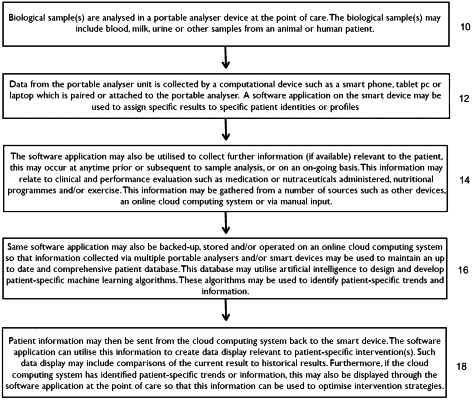| CPC G16H 50/20 (2018.01) [G16H 50/70 (2018.01)] | 20 Claims |

|
1. A system for analysis of medical and health-related data, for use in optimizing patient-specific intervention strategies using point of care diagnostics, comprising:
a portable analyzer unit, such as a machine, instrument or reader, that receives a sample associated with a patient and enables an analysis thereof;
a software application for use in the analysis of the sample, including diagnosis, trend, and intervention evaluation; and
a database stored at a central or distributed environment, such as at a cloud computing system that enables sharing of patient sample data as received via the portable analyzer unit for use by the software application in analysis and optimizing patient-specific intervention strategies using point of care diagnostics;
wherein the system operates to receive patient-specific information as data from multiple sources over a period of time, and uses machine learning to identify patterns or trends in the data that are specific to particular patients, including comparing data received at multiple time points with performance measurements of the patients taken at those time points, to determine performance indications for the patients; and
wherein the software application displays, at a user interface,
one or more reference points, ranges, or results indicative of a physical status of the patient at various time points, and
a patient-specific intervention based on the performance measurements of the patient at the various time points, the patient-specific information associated with the patient and collected by the system over the period of time, and the patterns or trends in the data received from the multiple sources.
|